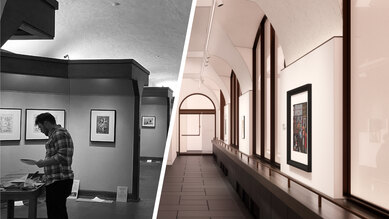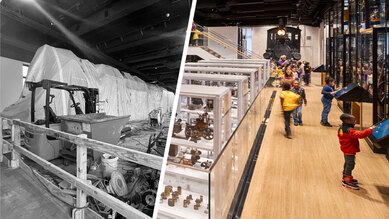Built to Evolve: Early Planning for Adapting Cultural Facilities

We strongly encourage a rigorous planning and programming process, tailored to your institution and your needs, to make sense of all the factors that may shape your capital project.
Pictured is an interior renovation that created new collections storage for Michigan State University.
Whether facing outdated infrastructure or evolving visitor expectations, our cultural planning experts offer advice on the early planning efforts museums and cultural institutions should undertake prior to renovating or expanding their facilities.
Like most community buildings, cultural facilities are valuable assets, serving as centers for learning, well-being and economic development. Cultural organizations have the unique challenge of being the epicenter for celebration and protection of the visual and performing arts, stories and objects that define a community or culture.
Today, many cultural organizations face ever-evolving challenges, forcing them to reconsider their built facilities. Many are in buildings that are outdated, failing, or undersized, others are rethinking their facilities to enable new revenue streams, or looking at how to enhance connections with their target audiences. Still others find that as technology evolves, the expectations of visitors are shifting.
But undertaking a capital building project to adapt an existing facility, no matter its size, is no small feat. Before any museum, theatre, visitor center, historic site or other cultural organization contemplates design and construction, we strongly encourage a rigorous planning and programming process, tailored to your institution and your needs, to make sense of all the factors that may shape your capital project.
Four essential plans for adapting cultural spaces
Since many cultural institutions are operating with limited funding, it’s important to do thorough due diligence before you embark on a fundraising campaign, donation request or grant application to make a capital project possible. There are several types of early planning we strongly recommend that help your organization identify all the factors that will affect your potential renovation, expansion or rehabilitation project.
- Facility assessment – a comprehensive building condition review
- Collections assessment – an audit of spatial and operational collection health
- Feasibility study – an assessment of project viability
- Master plan – a long-term strategic framework

It's important to complete a thorough facility assessment to know what's possible for your building before you start dreaming big.
Pictured is a future gallery transformation at Detroit Institute of Arts.
Facility Assessment: a non-negotiable evaluation of your existing building
Before you begin to adapt an existing building, you need to start with a thorough understanding of its current state. This is essentially a “home inspection” for your facility and begins with a deep dive into existing building documentation from the original construction and any prior alterations. It will also include a visual survey of the existing condition of the building systems and materials, identifying safety concerns, required maintenance, and proposed remediations or repairs. With available laser scanning technology, the facility assessment is also the perfect time to capture the current state of the building in a digital Building Information Model (BIM model). All this information not only helps you tackle the existing challenges in your facility but also illuminates what’s possible for any future renovations. While it can be tempting to jump straight into a building master plan or interpretive planning, it’s important to know what’s possible for your building before you start dreaming big.
Collections Assessment: A multifaceted, holistic examination of your collections
If the building represents the skeleton of an institution, the collections are at the heart. For many institutions, their collections spark relationships with the community—visitors, students, educators, local leaders, and more. Every collection is unique and ever-changing, and different objects have different environmental and spatial needs to keep them safely preserved. A holistic collections assessment evaluates the volume of your current inventory, required adjacencies and support spaces, and future growth needs. It also analyzes how the collection could compress or expand in a variety of storage arrangements, and whether it may need to swing to alternative spaces—either temporarily or permanently—to accommodate access and operations during any renovation or expansion of your facility.

A holistic collections assessment helps ensure the optimal safekeeping and future growth of your collections are considered in any renovation or expansion project.
Pictured is the renovation of a gallery into an open collections experience at The Franklin Institute.
Feasibility Study: Increasing confidence in your project's viability
Once you’ve assessed your facility and collections, you’re better positioned to do a deeper dive into whether a proposed capital project is viable and worth pursuing. Visioning and goal setting aligns your stakeholders on priorities, outcomes and programmatic requirements. Defining your space program including room typologies and adjacencies can help determine whether you’re addressing your needs holistically. Evaluating potential areas of renovation for alignment with your vision and functional requirements is key. Multiple high-level conceptual options are developed to address the goals, opportunities and challenges of the potential project, and these options are analyzed and refined. Cost evaluation can be performed to provide early rough order of magnitude (ROM) estimates and even more detailed analysis for selected concepts. Ultimately, the feasibility study is about reducing uncertainty and increasing confidence before committing further resources. It helps the decision-makers determine whether to move forward, revise the concept, or shelve it altogether.
Master Plan: Maximizing the potential of your facilities
The elements of a facility master plan may include strategic and resiliency planning; operational and departmental planning; economic and financial planning; environmental and cultural considerations; or even more comprehensive elements like land use, infrastructure and utilities, sustainability strategies, and implementation phasing. Each master plan reflects the organization’s unique context, history, mission and vision. It also incorporates input from diverse stakeholders including staff, visitors, board members, volunteers, and surrounding communities. And the most successful master plans ensure flexibility and adaptability for future changes in the organization.
The sequence of a master plan and a feasibility study can vary depending on the project’s goals and requirements. In many cases, a feasibility study is conducted first to assess the potential for project success. In other cases, feasibility studies and master plans are conducted concurrently as part of an integrated process. And sometimes a master plan may precede a feasibility study, particularly when it sets the broader vision and framework for development.

A well-developed and inclusive master plan maximizes your the potential of your existing facilities, planning for your organization's future change.
Pictured is the future renovation and expansion of the North Carolina Museum of History.
Collective vision, curated impact
While facility adaptations can be disruptive, they can also be transformative, catalyzing new interest and excitement in your institution and your community. These early planning efforts are your first opportunities to build understanding, connection and consensus among your staff and stakeholders and spark advocacy for the future state.
Consider whose input you need (staff, board, donors, members, local leaders), whose input you might desire (new audiences), and how to connect with each of these groups effectively. Understanding each of your stakeholder groups is the key to connecting with each and ensuring an inclusive, transparent and effective engagement process.
Planning isn’t optional—it's foundational
While ‘due diligence’ may sound a little like eating your veggies before your dessert, these are crucial first steps in what can be a thrilling and transformative journey toward the future you envision for your organization. The more information you have in hand, the better positioned you will be to maximize opportunity, earn the goodwill of your community and supporters, and allocate your financial resources purposefully. If your cultural organization anticipates future facility adaptations, reach out to our cultural planning experts to talk through your needs and begin your own planning process.
Ready to begin your cultural facility planning journey?
Contact our experts in museum and cultural facility planning.